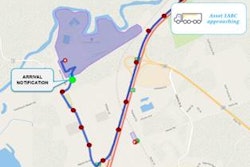Software company Locus Technologies has been awarded a second patent this year that will benefit last-mile carriers and their drivers, among others.
Locus’ “Machine Learning Models for Predicting Time in Traffic” patent offers logistics providers hyper-accurate estimated travel times, delivering enhanced predictability in their last-mile deliveries by factoring in traffic patterns, which have historically been considered too dynamic to map.
The patent covers unique technology that analyzes the historical data of traffic and predicts the travel time between origin and destination locations. It also factors in sub-variables such as day of the week and time of day.
Locus Founder and CEO Nishith Rastogi said the data will come from diverse sources, including internal, external or a mix of both. The modeling can deliver accurate predictions depending on availability, cost and accessibility, among other factors, he said.
“The more massive the data volumes, the better the traffic predictions,” Rastogi said. “Some businesses that operate on a large scale may prefer to do this modeling on top of their in-house data sets, which they would have derived from their day-to-day operations and fleet management processes. However, others might depend on partners such as us to solve this.
“Take for example, at Locus, one of the features offered as a part of our dispatch management platform is route planning. Our data comes from the executed deliveries, as we have GPS trails of the riders,” he added. “Through our patented technology and a host of other dynamic routing algorithms on this data set, we are able to accurately predict the time taken between point A to point B by accounting for 180+ business and around 250+ hard and soft real-world constraints. This is how we are able to create the most efficient routes for all orders for our clients.”
Accurate prediction of time in traffic is largely a feature delivered by map providers like Google. Such technology giants have control over the Android ecosystem, allowing them to do this at an unimaginable scale.










